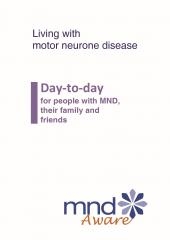72 page A4 book providing strategies for living at home with MND, more in-depth information and day-to-day tips.
- View free online Living with motor neurone disease: day-to-day for people with MND, their family and friends
- Hardcopy available - free for members in NSW, ACT and NT; small fee for others.
Topics covered:
Getting information about MND
Using the Internet as a health information source
Feelings and attitudes, and those of family and friends
Feelings and attitudes
Communicating about emotional issues
Talking with young people about MND
Friends
Linking up with others
Planning ahead
Possible planning steps
Preparing a Will (NSW)
Making a Power of Attorney (NSW)
Appointing an Enduring Guardian (NSW)
What is legal capacity? (NSW)
What is Advance Care Planning and an Advance Care Directive?
Around the home
How can an occupational therapist help?
Getting in and out of your home
Inside your home
Slips, trips and falls
Safe use of a wheelchair
Getting comfortable
How can a physiotherapist help?
Temperature control
Managing swollen ankles, feet and hands
Preventing pressure sores
Moving yourself from one position or place to another
How someone can help you move from one position or place to another
Tips for a comfortable hospital, respite or residential care stay
Everyday personal care
If someone is helping you with your personal care
Showering
Eye, nose and ear care
Hair care
Mouth and teeth care
Skin care
Nails
Shaving
Toileting
Menstruation
Clothing and dressing
Eating well
Getting advice from a dietitian, speech pathologist and occupational therapist
Timing of meals and drinks
Liquids
To help prevent weight loss or to regain weight
Preparation and presentation
Commercially available products for boosting energy intake
When someone is assisting you to eat or drink
Recommendations from health professionals for food consistency
Communication
Communication and MND
Regular review of communication needs
Communication tips
Strategies often suggested
Call devices
Care alerters
Environmental control units
Living independently at home
MND and health and community care services
Getting your needs and issues dealt with
Getting through the ‘paperwork' and understanding services
Making appointments and amalgamating service visits
Getting your issues dealt with
When your extended family, friends or neighbours want to help
Keeping track of services, contacts and day-to-day care
Leisure
Getting around
Holidays and travelling longer distances
Some ideas for maintaining interests and hobbies
Staying connected
The later stage of MND
Publication update
MND NSW is currently in the process of updating this publication to include the following information about Voluntary Assisted Dying (VAD) which has been adapted from the MND Australia Planning Ahead Fact Sheet, updated July 2024
Voluntary Assisted Dying (VAD) is one choice available to eligible people at end of life. A person may access palliative care and VAD at the same time.
With VAD, a person in the late stages of advanced disease chooses to end their life with medical assistance. VAD is currently legally available in New South Wales, Queensland, South Australia, Tasmania, Victoria and Western Australia, with strict eligibility criteria. This means people with MND may have access to VAD, should they wish to pursue it.
The eligibility criteria and process for VAD differs slightly from state to state. If you are thinking about VAD, or would like more information, ask your doctor or healthcare team about it. In some states, doctors or healthcare providers may not be legally allowed to start a conversation about VAD, so you may need to raise the topic.


